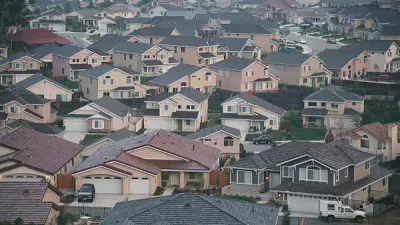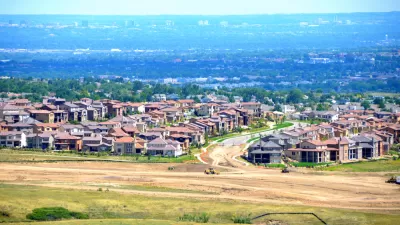A familiar argument of suburban apologists is that people prefer suburban environments over urban environments. Joe Cortright reminds us, however, that "revealed preference" doesn't tell the whole story.

"One of the chief arguments in favor of the suburbs is simply that that is where millions and millions of people actually live," according to an article by Joe Cortright that sets out to debunk that claim.
The counterargument, of course, is that people can only choose from among the options presented to them. And the options for most people are not evenly split between cities and suburbs, for a variety of reasons, including the subsidization of highways and parking, school policies, and the continuing legacies of racism, redlining, and segregation. One of the biggest reasons, of course, is restrictive zoning, which prohibits the construction of new urban neighborhoods all over the country.
Cortright wants to consider whether zoning really actually acts as a constraint on more compact, urban housing by turning to the work of Jonathan Levine and detailed in the book Zoned Out. Cortright wants to get to the bottom of the issue about whether or not there is pent up demand in the market for walkable urban places, and then whether land use regulations make it impossible to build the supply to meet that demand. The point made originally by Levine and explained here again by Cortright: it's true that in some places there is a shortage of cities and an overabundance of suburban-style house. In other metropolitan areas, there's a shortage of all kinds of housing.
FULL STORY: The myth of revealed preference for suburbs

Depopulation Patterns Get Weird
A recent ranking of “declining” cities heavily features some of the most expensive cities in the country — including New York City and a half-dozen in the San Francisco Bay Area.

California Exodus: Population Drops Below 39 Million
Never mind the 40 million that demographers predicted the Golden State would reach by 2018. The state's population dipped below 39 million to 38.965 million last July, according to Census data released in March, the lowest since 2015.

Chicago to Turn High-Rise Offices into Housing
Four commercial buildings in the Chicago Loop have been approved for redevelopment into housing in a bid to revitalize the city’s downtown post-pandemic.

New Park Opens in the Santa Clarita Valley
The City of Santa Clarita just celebrated the grand opening of its 38th park, the 10.5-acre Skyline Ranch Park.

U.S. Supreme Court: California's Impact Fees May Violate Takings Clause
A California property owner took El Dorado County to state court after paying a traffic impact fee he felt was exorbitant. He lost in trial court, appellate court, and the California Supreme Court denied review. Then the U.S. Supreme Court acted.

How Urban Form Impacts Housing Affordability
The way we design cities affects housing costs differently than you might think.
City of Costa Mesa
Licking County
Barrett Planning Group LLC
HUD's Office of Policy Development and Research
Mpact Transit + Community
HUD's Office of Policy Development and Research
City of Universal City TX
ULI Northwest Arkansas
Town of Zionsville
Urban Design for Planners 1: Software Tools
This six-course series explores essential urban design concepts using open source software and equips planners with the tools they need to participate fully in the urban design process.
Planning for Universal Design
Learn the tools for implementing Universal Design in planning regulations.






















